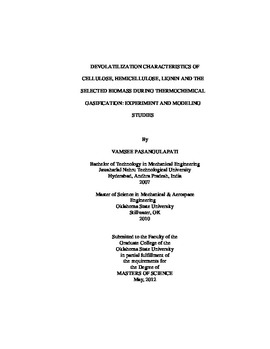| dc.contributor.advisor | Kumar, Ajay | |
| dc.contributor.author | Pasangulapati, Vamsee | |
| dc.date.accessioned | 2014-02-25T00:21:08Z | |
| dc.date.available | 2014-02-25T00:21:08Z | |
| dc.date.issued | 2012-05-01 | |
| dc.identifier.uri | https://hdl.handle.net/11244/7960 | |
| dc.description.abstract | Pyrolysis and gasification are two promising thermochemical conversion technologies for conversion of biomass into fuels, chemicals and power. Devolatilization is the first major process that occurs in biomass gasification and pyrolysis. Thus it is essential to study the fundamentals of biomass devolatilization, which helps in better understanding, modeling and optimization of biomass thermochemical conversion processes. The devolatilization characteristics of biomass major components cellulose, hemicellulose and lignin were investigated using thermogravimetric analysis. The weight loss kinetics were derived using global decomposition approach. Spectral analysis was conducted and major gases such as CO, CO2 and CH4 were identified along with hydrocarbons, alcohols, ketones and acids. The devolatilization characteristics of switchgrass, wheat straw, eastern red cedar and DDGS were investigated using thermogravimetric analysis. The focus of this objective was to investigate how the biomass components contributed to yields and properties of products during devolatilization. Results show that the effect of biomass composition on thermal degradation profiles and weight loss kinetics was not significant. However, with change in biomass composition, significant effects were observed on CO, CO2 and CH4 evolution profiles. Carbon based conversion efficiency was higher for switchgrass (94.2%) and wheat straw (95.0%) and lower for red cedar (77.0%) and DDGS (76.8%). A CFD model for switchgrass gasification in a fluidized bed reactor was developed using devolatilization kinetics obtained from thermogravimetric analysis. The simulation results provided detailed information on temperature and gas concentration profiles inside the reactor. The non-uniform distribution of temperature in the reactor showed the different reaction zones for devolatilization, combustion and gasification. The model validation was performed by comparing the predicted outlet concentrations of the gases with experimental data. The sensitivity of the model was also analyzed by simulating at two equivalence ratios of 0.32 and 0.29. | |
| dc.format | application/pdf | |
| dc.language | en_US | |
| dc.publisher | Oklahoma State University | |
| dc.rights | Copyright is held by the author who has granted the Oklahoma State University Library the non-exclusive right to share this material in its institutional repository. Contact Digital Library Services at lib-dls@okstate.edu or 405-744-9161 for the permission policy on the use, reproduction or distribution of this material. | |
| dc.title | Devolatilization Characteristics of Cellulose, Hemicellulose, Lignin and the Selected Biomass During Thermochemical Gasification: Experiment and Modeling Studies | |
| dc.type | text | |
| dc.contributor.committeeMember | Jones, Carol L. | |
| dc.contributor.committeeMember | Wilkins, Mark R. | |
| osu.filename | Pasangulapati_okstate_0664M_12068.pdf | |
| osu.college | Engineering, Architecture, and Technology | |
| osu.accesstype | Open Access | |
| dc.description.department | Biosystems and Agricultural Engineering | |
| dc.type.genre | Thesis | |
| dc.subject.keywords | biomass | |
| dc.subject.keywords | cfd modelling | |
| dc.subject.keywords | gasification | |
| dc.subject.keywords | switchgrass | |
| dc.subject.keywords | syngas | |
| dc.subject.keywords | tga-ftir | |
